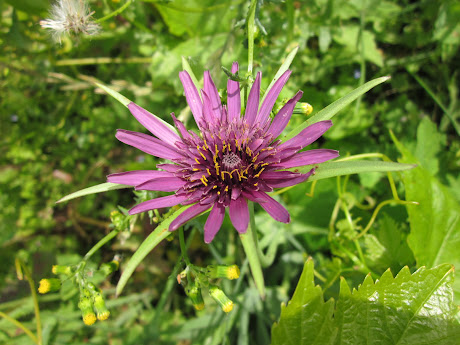Book Review: Two for Practicality
Whilst we can look up practically everything on the internet these days, sometimes you just can't beat a good book to find out what's needed. Today, I'm going to review two books I've received this year which come firmly under the practical heading.
First up is Jim Gardiner's Encyclopedia of Flowering Shrubs. If you're looking to add some shrubbery to your garden, or to simply decipher what you've inherited there, this is the book for you. There's over 1,500 shrubs described and clearly pictured, so it's one of the most comprehensive guides available. It's arranged in alphabetical latin name order with each shrub having a short description, a good photograph of it in flower, plus a guide to eventual height, ideal growing conditions and cultural notes. There's an indication if the shrub has been awarded the RHS AGM plus the USA's hardiness zone.
The short Table of Selected Shrubs by Key Design and Cultural Characteristics towards the end is what elevates this book to greatness. This is the first port of call for readers wanting to ID a mystery shrub or to select something new for their garden. The colourful guide to foliage type, flower colour, size, light requirements, flowering season, soil type and Zone allows the reader to shortlist shrubs which fit either their ID needs or garden requirements, which can then be looked up in the main part of the book. This is something which is currently hard to achieve via the internet, though there are a number of sites which are working on it!
Definitely one for a gardener's reference bookshelf in either the UK or on the other side of the pond.
Looking at The A to Z of Plant Names' entry on Amazon, it looks like this might be an update to an earlier edition dating back to 1985. As plant DNA analysis is regularly renaming many of our garden plants (much to the frustration of this gardener sometimes!), a revised edition is to be welcomed.
Any keen gardener soon recognises Latin as the common language of all gardeners, but sadly most of us aren't Latin scholars. However, by understanding the Latin 'codewords' used to name our plants, it means we can deduct much about other plants bearing the same names. Thus chinenis shows the plant originates from China and striatus means the plant is striped.
Allen J Coombes' book breaks the 'code' for 4,000 of our most commonly used plants. A brief introduction describes how the binomial plant naming structure of Genus + species name (aka epithet) came about, then moves swiftly through a guide to pronunciation, how to use the book and a list of the most commonly used epithets and their meanings.
The bulk of the book is in alphabetical order and is dedicated to unravelling the meaning of the names. Most of the entries start with a Genus, followed by a listing of the common species names relating to that Genus. Both Genus and species entries hold a wealth of information, some of which is abbreviated, so the abbreviation guide on page 22 should be kept to hand. The identity of the person who first named the plant is also given. Unfortunately this is in abbreviated form and there's no handy guide to telling who L. may be (the great Linnaeus?), or Desf. etc.
The book also lists common names amongst the Latin, so the reader is then pointed to the appropriate Genus name for the full entry. The older, now defunct Latin names are also listed e.g. under the entry for Dicentra, the species list includes spectabilis, which points the reader to its new name of Lamprocapnos spectabilis.
A good book for demystifying Latin names and learning some of the history and origin of many of our best known, and loved plants.
Disclosure: I received review copies of these books for honest review purposes. The links to Amazon are meant for your reference only and I don't receive a penny if you decide to make a purchase.
First up is Jim Gardiner's Encyclopedia of Flowering Shrubs. If you're looking to add some shrubbery to your garden, or to simply decipher what you've inherited there, this is the book for you. There's over 1,500 shrubs described and clearly pictured, so it's one of the most comprehensive guides available. It's arranged in alphabetical latin name order with each shrub having a short description, a good photograph of it in flower, plus a guide to eventual height, ideal growing conditions and cultural notes. There's an indication if the shrub has been awarded the RHS AGM plus the USA's hardiness zone.
The short Table of Selected Shrubs by Key Design and Cultural Characteristics towards the end is what elevates this book to greatness. This is the first port of call for readers wanting to ID a mystery shrub or to select something new for their garden. The colourful guide to foliage type, flower colour, size, light requirements, flowering season, soil type and Zone allows the reader to shortlist shrubs which fit either their ID needs or garden requirements, which can then be looked up in the main part of the book. This is something which is currently hard to achieve via the internet, though there are a number of sites which are working on it!
Definitely one for a gardener's reference bookshelf in either the UK or on the other side of the pond.
Looking at The A to Z of Plant Names' entry on Amazon, it looks like this might be an update to an earlier edition dating back to 1985. As plant DNA analysis is regularly renaming many of our garden plants (much to the frustration of this gardener sometimes!), a revised edition is to be welcomed.
Any keen gardener soon recognises Latin as the common language of all gardeners, but sadly most of us aren't Latin scholars. However, by understanding the Latin 'codewords' used to name our plants, it means we can deduct much about other plants bearing the same names. Thus chinenis shows the plant originates from China and striatus means the plant is striped.
Allen J Coombes' book breaks the 'code' for 4,000 of our most commonly used plants. A brief introduction describes how the binomial plant naming structure of Genus + species name (aka epithet) came about, then moves swiftly through a guide to pronunciation, how to use the book and a list of the most commonly used epithets and their meanings.
The bulk of the book is in alphabetical order and is dedicated to unravelling the meaning of the names. Most of the entries start with a Genus, followed by a listing of the common species names relating to that Genus. Both Genus and species entries hold a wealth of information, some of which is abbreviated, so the abbreviation guide on page 22 should be kept to hand. The identity of the person who first named the plant is also given. Unfortunately this is in abbreviated form and there's no handy guide to telling who L. may be (the great Linnaeus?), or Desf. etc.
The book also lists common names amongst the Latin, so the reader is then pointed to the appropriate Genus name for the full entry. The older, now defunct Latin names are also listed e.g. under the entry for Dicentra, the species list includes spectabilis, which points the reader to its new name of Lamprocapnos spectabilis.
A good book for demystifying Latin names and learning some of the history and origin of many of our best known, and loved plants.
Disclosure: I received review copies of these books for honest review purposes. The links to Amazon are meant for your reference only and I don't receive a penny if you decide to make a purchase.












I was thinking how interesting I'd find the second book (a bit in the way of an ordinary dictionary - it can be riveting simply to turn the pages at random) until you said about the names of the people who named the plants. The presence of that kind of information can be the icing that sweetens the Latin.
ReplyDeleteLucy - I agree. A section in the introduction on who the mysterious L., R Br, Desf. et al. are would be really interesting.
ReplyDelete"This is something which is currently hard to achieve via the internet, though there are a number of sites which are working on it!"
ReplyDeleteWhat sites? You have to tell me! Pleeease.
P.S. L. is for Linnaeus. See Wikipedia for any others.
Phytographer - welcome! Which sites they'll be only time will tell. It needs an organisation or company with a large database of plants and the wherwithall to develop the kind of queries which will allow the enquirer to enter the information they have or want in terms of the shrub they're looking for and for a list of possibilities to be returned.
ReplyDeleteIt could be the RHS via their Plant Finder or it could be a group of nurseries developing their own database which then links through for sales.
I've seen a couple of examples of the latter which have the potential for this, but it's too early to say whether they'll actually achieve it.